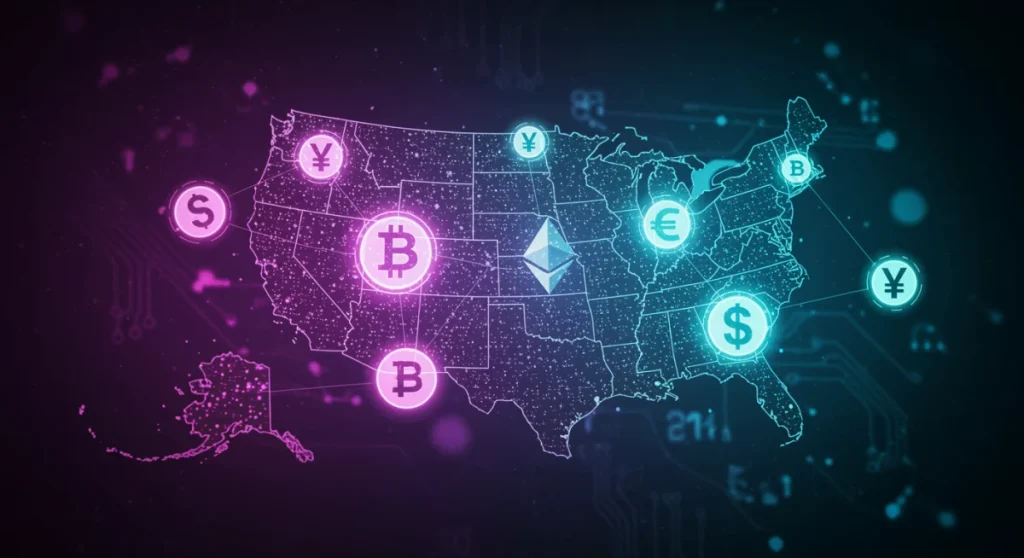Digital Currency in US: 2025 Regulatory Landscape & Investment

Anúncios
The US digital currency landscape in 2025 is poised for significant regulatory evolution, influencing investment opportunities across various sectors, from stablecoins to decentralized finance, demanding careful navigation and strategic foresight.
Anúncios
The financial world stands at the precipice of a transformative era, with US Digital Currency Future being a focal point of innovation and regulatory debate. As we approach 2025, the trajectory of digital assets within the United States is becoming clearer, yet remains fraught with complexities. This article delves into the anticipated regulatory landscape and explores the myriad investment opportunities emerging from this dynamic environment.
Understanding the Evolving Regulatory Environment
The regulatory framework for digital currencies in the United States has been a patchwork of state and federal initiatives, often leading to uncertainty. However, as 2025 approaches, there’s a concerted effort to establish more cohesive and comprehensive guidelines. This push is driven by the rapid adoption of digital assets and the increasing need for consumer protection and financial stability.
Anúncios
Key agencies like the Securities and Exchange Commission (SEC), the Commodity Futures Trading Commission (CFTC), and the Treasury Department are actively shaping policies. Their goal is to balance innovation with oversight, ensuring that the US remains a leader in financial technology while mitigating risks associated with illicit activities and market manipulation. The coming years are expected to bring more clarity, defining digital assets as securities, commodities, or a new class altogether.
Legislative Initiatives and Their Impact
Several legislative proposals are currently under consideration, aiming to provide a clearer legal foundation for digital currencies. These initiatives seek to address issues such as stablecoin regulation, central bank digital currencies (CBDCs), and the taxation of digital assets.
- Stablecoin Legislation: Expected to define stablecoins’ legal status, reserve requirements, and operational standards, potentially boosting their adoption as a reliable digital payment method.
- CBDC Exploration: The Federal Reserve continues to research a potential digital dollar, with policy discussions focusing on privacy, financial inclusion, and international implications.
- Taxation Clarity: Efforts are underway to simplify tax reporting for digital asset transactions, a move crucial for mainstream adoption and investor confidence.
The culmination of these efforts will likely result in a more structured environment, fostering greater institutional participation and broader public acceptance. This regulatory evolution is not merely about imposing rules; it’s about building a robust and secure foundation for the next generation of financial services.
The Rise of Central Bank Digital Currencies (CBDCs) in the US
The concept of a US Central Bank Digital Currency (CBDC), often referred to as the ‘digital dollar,’ has gained significant attention. While not yet a certainty, the Federal Reserve continues to research and discuss its potential implications. A CBDC could fundamentally alter the financial infrastructure, offering new ways to conduct transactions and manage monetary policy.
Proponents argue that a digital dollar could enhance payment efficiency, reduce transaction costs, and improve financial inclusion for underserved populations. It could also strengthen the dollar’s international standing in a rapidly digitizing global economy. However, concerns regarding privacy, cybersecurity, and the potential impact on commercial banks remain central to the ongoing debate.
Potential Benefits and Challenges of a Digital Dollar
The introduction of a CBDC is not without its complexities. While offering numerous advantages, it also presents significant hurdles that must be carefully navigated.
- Enhanced Security: A CBDC could offer a more secure and resilient payment system, less susceptible to cyber threats than existing digital payment methods.
- Financial Inclusion: By providing a government-backed digital payment option, a CBDC could extend financial services to individuals without traditional bank accounts.
- Monetary Policy Tools: A digital dollar could offer the Federal Reserve new levers for implementing monetary policy, potentially allowing for more targeted interventions.
Conversely, challenges include the massive technological infrastructure required, safeguarding user privacy, and ensuring that a CBDC does not destabilize the commercial banking sector. The decision to launch a digital dollar will be a monumental one, reflecting a careful balance of innovation, risk, and societal benefit.
Key Investment Opportunities in the Digital Currency Space
The evolving regulatory landscape and technological advancements are creating a fertile ground for investment in the digital currency space. Beyond the well-known cryptocurrencies like Bitcoin and Ethereum, new opportunities are emerging in various sub-sectors, each with its unique risk and reward profile.
Investors are increasingly looking at infrastructure plays, stablecoins, decentralized finance (DeFi), and non-fungible tokens (NFTs). Understanding the underlying technology and the regulatory environment is paramount to making informed investment decisions in this volatile yet promising market.
Emerging Investment Avenues
As the digital asset ecosystem matures, several key areas are attracting significant capital and innovation. These represent the forefront of investment in the US digital currency future.
- Blockchain Infrastructure: Investing in companies that build and maintain the foundational technology for digital assets, such as mining operations, wallet providers, and blockchain development platforms.
- Stablecoins and Payment Solutions: As regulatory clarity increases, stablecoins could become a cornerstone of digital payments, offering investment opportunities in their issuers and related payment services.
- Decentralized Finance (DeFi): The DeFi sector, encompassing lending, borrowing, and trading platforms built on blockchain, continues to grow, offering high-yield opportunities but also higher risks.
- Tokenized Real-World Assets: The tokenization of traditional assets like real estate, art, and commodities could unlock new liquidity and investment avenues.
Navigating these opportunities requires a deep understanding of market dynamics, technological shifts, and the anticipated regulatory trajectory. Diversification and a long-term perspective are crucial for success in this rapidly changing environment.

Technological Innovations Driving Digital Currency Adoption
Beyond regulatory shifts, technological innovations are the bedrock of digital currency adoption and expansion. Advances in blockchain technology, cryptography, and distributed ledger technologies (DLT) are making digital assets more secure, efficient, and scalable. These innovations are not only improving existing digital currencies but also paving the way for entirely new applications and use cases.
For instance, layer-2 scaling solutions are addressing the scalability issues of major blockchains, enabling faster and cheaper transactions. Cross-chain interoperability protocols are allowing different blockchains to communicate, fostering a more interconnected digital asset ecosystem. These advancements are critical for the mainstream integration of digital currencies into daily financial activities.
Impact of Blockchain Advancements
Blockchain technology continues to evolve at a rapid pace, with new developments constantly pushing the boundaries of what’s possible in the digital asset space.
- Scalability Solutions: Innovations like sharding, rollups, and sidechains are dramatically increasing transaction throughput, making blockchains more viable for high-volume applications.
- Enhanced Security Features: Ongoing research in cryptography and zero-knowledge proofs is improving the privacy and security of digital transactions, addressing critical user concerns.
- Interoperability Protocols: Projects focused on enabling seamless communication and asset transfer between different blockchains are fostering a more integrated and efficient digital economy.
These technological leaps are lowering barriers to entry, making digital currencies more accessible and user-friendly for both individuals and institutions. The continuous evolution of these technologies ensures that the digital currency landscape will remain dynamic and full of potential.
Challenges and Risks in the US Digital Currency Market
While the future of digital currency in the US holds immense promise, it is also accompanied by significant challenges and risks. These include regulatory uncertainty, market volatility, cybersecurity threats, and the potential for illicit use. Investors and participants in this market must exercise caution and conduct thorough due diligence.
Regulatory uncertainty, despite efforts for clarity, can still lead to abrupt market shifts and impact the viability of certain projects. The inherent volatility of many digital assets means that investments can experience rapid price fluctuations. Furthermore, the decentralized nature of some digital currencies can make them attractive for money laundering and other illegal activities, posing a challenge for regulators.
Navigating the Complexities
Addressing these challenges requires a multi-faceted approach, involving both technological safeguards and robust regulatory frameworks.
- Regulatory Compliance: Staying abreast of evolving regulations is crucial for businesses and investors to avoid legal pitfalls and ensure sustainable operations.
- Cybersecurity Measures: Implementing stringent cybersecurity protocols is paramount to protecting digital assets from hacking and theft, a constant threat in the digital realm.
- Market Education: Educating investors about the risks associated with digital assets, including volatility and potential scams, is essential for fostering a healthier market.
Successfully navigating these challenges will be key to unlocking the full potential of the digital currency market in the US. A collaborative effort between regulators, industry leaders, and consumers is necessary to build a secure, transparent, and resilient ecosystem.
The Role of Institutional Adoption and Mainstream Integration
The widespread adoption of digital currencies hinges significantly on institutional participation and their integration into mainstream financial services. As regulatory clarity improves and technological infrastructure strengthens, more traditional financial institutions are exploring and entering the digital asset space. This trend is a strong indicator of the growing legitimacy and long-term potential of digital currencies.
Major banks, asset managers, and payment processors are investing in blockchain technology, offering crypto-related services, and even launching their own digital asset products. This institutional embrace is crucial for bringing greater liquidity, stability, and trust to the market, moving digital currencies from a niche investment to a staple of modern finance.
Pathways to Mainstream Acceptance
Several factors are contributing to the increasing mainstream acceptance and institutional adoption of digital currencies.
- Custodial Services: The development of secure and regulated custodial solutions for digital assets is enabling institutional investors to hold cryptocurrencies with confidence.
- ETFs and Investment Products: The approval of cryptocurrency exchange-traded funds (ETFs) and other regulated investment vehicles provides traditional investors with easier access to digital assets.
- Partnerships and Integrations: Collaborations between fintech companies and established financial institutions are leading to innovative products and services that bridge the gap between traditional and digital finance.
This institutional push is not just about investment; it’s about embedding digital currencies into the very fabric of the global financial system. As these integrations deepen, the US digital currency future will become increasingly intertwined with the broader economy, ushering in a new era of financial innovation.
| Key Aspect | Brief Description |
|---|---|
| Regulatory Clarity | US seeks comprehensive guidelines by 2025 for digital assets, stablecoins, and CBDCs. |
| Investment Avenues | Opportunities in blockchain infrastructure, stablecoins, DeFi, and tokenized assets. |
| Technological Drivers | Advancements in scalability, security, and interoperability are fueling adoption. |
| Institutional Adoption | Mainstream financial institutions increasingly integrate digital assets into services. |
Frequently Asked Questions About US Digital Currency
The main goal is to establish a clear, comprehensive, and cohesive regulatory framework. This aims to balance fostering innovation in digital assets with ensuring consumer protection, market stability, and preventing illicit financial activities, thereby providing certainty for businesses and investors.
A US CBDC could streamline everyday transactions by offering a potentially faster, cheaper, and more secure digital payment method directly from the central bank. It might reduce reliance on commercial banks for certain transactions and enhance financial inclusion for unbanked populations.
Beyond traditional cryptocurrencies, promising areas include blockchain infrastructure companies, regulated stablecoin projects, decentralized finance (DeFi) platforms, and the tokenization of real-world assets. These sectors are poised for growth as the market matures and gains regulatory clarity.
Key risks include high market volatility, ongoing regulatory uncertainty that can affect asset classifications and legality, significant cybersecurity threats such as hacking and fraud, and the potential for market manipulation. Investors should exercise extreme caution and conduct thorough research.
Institutional adoption is bringing greater legitimacy, liquidity, and stability to the market. Major financial institutions are offering custodial services, launching crypto investment products like ETFs, and integrating blockchain technology, moving digital currencies into mainstream finance.
Conclusion
The future of digital currency in the US is undeniably bright, albeit complex. As 2025 approaches, the interplay of evolving regulatory frameworks, groundbreaking technological innovations, and increasing institutional adoption is setting the stage for a profound transformation of the financial landscape. While challenges such as market volatility and cybersecurity threats persist, the concerted efforts to establish clarity and security are paving the way for digital assets to become an integral part of the American economy. Investors and participants who navigate this dynamic environment with informed strategies and a forward-looking perspective stand to benefit from the immense opportunities that lie ahead.





